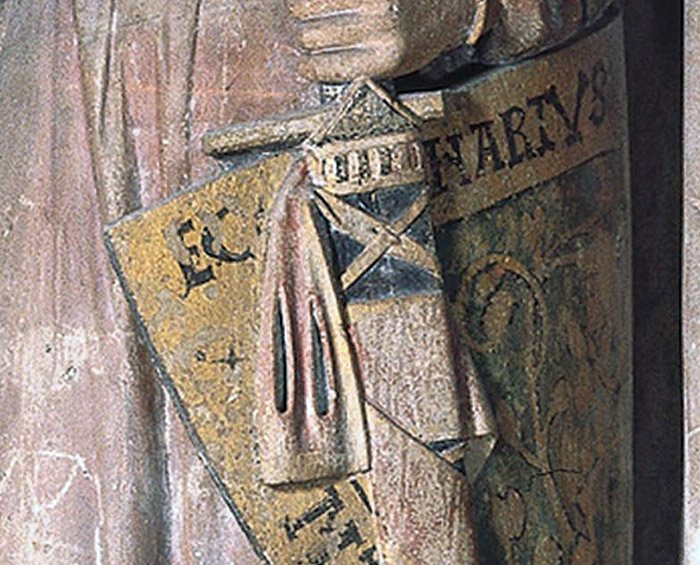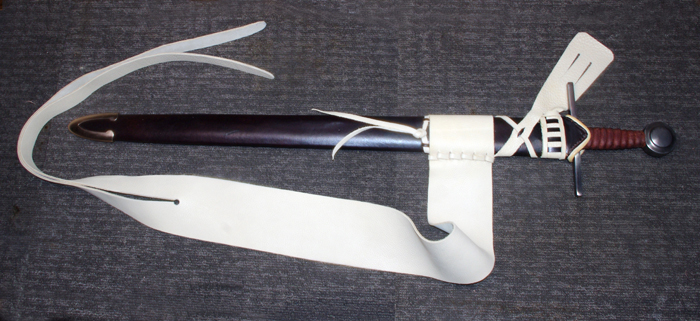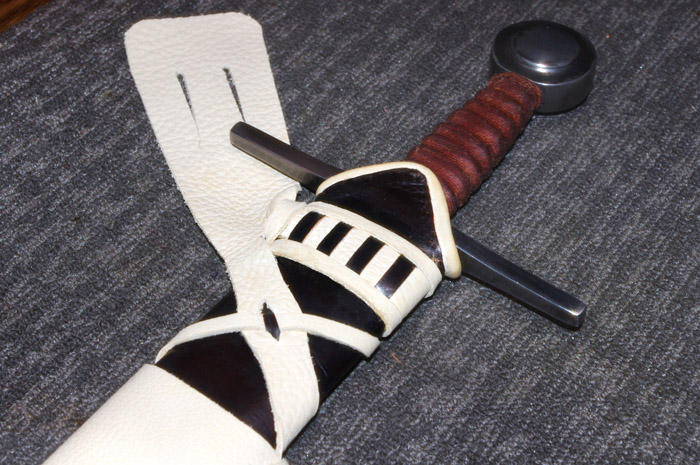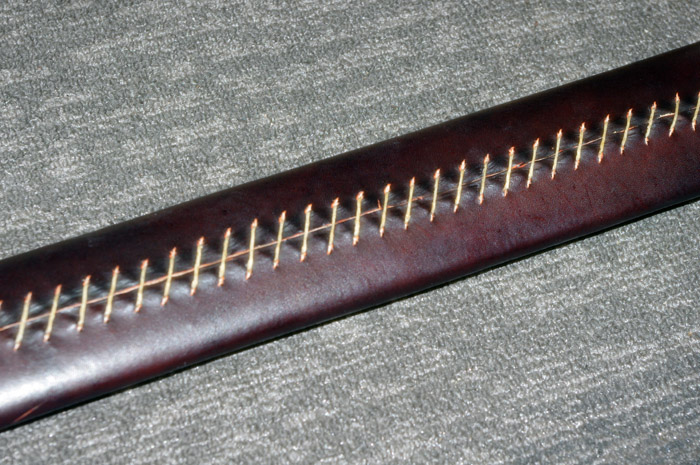| Author |
Message |
Harry Marinakis

|
 Posted: Thu 05 Feb, 2015 9:53 pm Post subject: Naumburg scabbard (DIY) Posted: Thu 05 Feb, 2015 9:53 pm Post subject: Naumburg scabbard (DIY) |
 |
|
I have a fascination with Medieval scabbards and thong belts, so I decided to try to reproduce one of the scabbards that can be seen on the statues at the Naumburg cathedral in Germany. Construction of the Naumburg cathdedral began right after AD 1200.
The scabbards depicted at the Naumburg cathedral are interesting in that the thong belts are extremely wide - about 4 inches wide. There are depictions of similarly-wide thong belts in the illuminated manuscript Elisabethpsalter (folio 139 verso), Germany, circa AD 1200-1220, but later (13th-14th C) thong belts of the German Empire were a tad bit narrow than these monsters.
The other interesting point about the Naumburg scabbards is that they all have an offset sword belt. To the best of my knowledge and research, the offset sword belt was developed right around AD 1200 - and the earliest depiction that I can find of an offset sword belt is also depicted in folio 139 verso in Elisabethpsalter.
So perhaps these extremely wide thong belts represent the "first generation" of the offset sword belt.
Reproducing the Naumburg scabbard presented several of challenges, all of which I managed to solve through a lot of experimentation and failure.
The first challenge was to find a suitable leather for the thong belt. There is at least one other thread that addressed this question. Oakeshott described the leather as "buckskin" in Records of the Medieval Sword - and looking at the soft, cloth-like characteristics of thong belt leather one would tend to agree. However, buckskin stretches too much to be of any use for a sword belt. I used oil-tanned Latigo leather in a cream color and I believe this is perfect. It is slightly elastic but does not stretch, is very strong and has a very soft (almost chamois-like) feel.
The second challenge was reproducing the striking lacing pattern noted on the Naumburg scabbards. After many months of staring at photos of this lacing, I finally figured out how to reproduce the pattern. To perfect the technique I make a mock-up of a scabbard and did some hands-on experimentation (see the DIY Scabbard thread).
The third and most difficult challenge - one that no none has ever addressed that I can tell - is the piping that I have seen around the edges of triangular rain guards of the Naumburg (and other) scabbards. Days of experimentation and multiple failures finally produced a solution, albeit not an ideal one.
Anyway, here it is.
 Attachment: 153.68 KB Attachment: 153.68 KB

 Attachment: 182.3 KB Attachment: 182.3 KB

Last edited by Harry Marinakis on Thu 05 Feb, 2015 10:32 pm; edited 5 times in total
|
|
  |
 |
Harry Marinakis

|
 Posted: Thu 05 Feb, 2015 9:55 pm Post subject: Posted: Thu 05 Feb, 2015 9:55 pm Post subject: |
 |
|
Here is the scabbard.
I started with a high-resolution photo of one of the Naumburg lacing patterns and carefully measured all of the strap widths and other parameters. I converted these measurements into fractions of the scabbard width. Then I multiplied these fractions by the width of my wood core to get real measurements for my scabbard. This way the proportions are identical to the Naumburg scabbard.
Sword is an Oakeshott Type XI (Del Tin 2121)
Bronze chape is from DBK's new line of chapes.
 Attachment: 249.03 KB Attachment: 249.03 KB

 Attachment: 159.82 KB Attachment: 159.82 KB

 Attachment: 168.46 KB Attachment: 168.46 KB

|
|
  |
 |
Martin Helgren

Location: Denmark Joined: 16 Jan 2007
Posts: 9
|
 Posted: Fri 06 Feb, 2015 12:31 am Post subject: Posted: Fri 06 Feb, 2015 12:31 am Post subject: |
 |
|
|
Nice Work! I always admire this amount of attention to detail and hands on research. Congratulations on a very nice scabbard!
|
|
   |
 |
Jerry Monaghan

|
 Posted: Fri 06 Feb, 2015 1:58 am Post subject: Posted: Fri 06 Feb, 2015 1:58 am Post subject: |
 |
|
Hi Martin
love what you have done very nice scabbard great detail congratulations on an fine job
Regards
Jerry Monaghan
|
|
  |
 |
Bryan Heff

|
 Posted: Fri 06 Feb, 2015 3:05 am Post subject: Posted: Fri 06 Feb, 2015 3:05 am Post subject: |
 |
|
Really nice! I like what you did just below the throat. Looks like it's integrated by passing through slits in the black leather but then perhaps the top and bottom gets an additional wrap with the white leather. I don't think I have seen that before. Very cool.
The church is near but the roads are icy. The tavern is far but I will walk carefully. - Russian Proverb
|
|
  |
 |
|
Radovan Geist
|
 Posted: Fri 06 Feb, 2015 3:12 am Post subject: Posted: Fri 06 Feb, 2015 3:12 am Post subject: |
 |
|
|
Thatīs a really nice job, indeed. Very clean, well-thought and backed by research. Congrats!
|
|
  |
 |
Harry Marinakis

|
 Posted: Fri 06 Feb, 2015 1:11 pm Post subject: Posted: Fri 06 Feb, 2015 1:11 pm Post subject: |
 |
|
Regarding the lacing below the mouth:
One strap from the thong was laced through the cover, then was split into two tails on the backside. Each of these tails were wrapped around front again, one above and one below. This gives you the ladder-like appearance.
Other stats:
Carved two-piece poplar wood core, 1/8" thick
Lined with 8 oz. woven wool fabric (fullered)
Veg tan leather cover 2-3 oz.
Linen thread whip stitch on the back seam
Straps are 6-8 oz. cream Latigo leather, sanded down to 3-4 oz. weight
I have always used a butted seam and cross stitch on the back seam until now but I don't have any evidence that such a stitch was used. The Vikings used a butted seam and whip stitch early on, but after AD 975 switched to closed seam and saddler's stitch.
Anyone have any evidence of the cross stitch on scabbards in the medieval period?
|
|
  |
 |
Brian K.
Industry Professional

Location: Salt Lake City, Utah Joined: 01 Jan 2008
Posts: 727
|
 Posted: Fri 06 Feb, 2015 1:49 pm Post subject: Posted: Fri 06 Feb, 2015 1:49 pm Post subject: |
 |
|
Outstanding work Harry. Even without any back story to your construction it's immediately obvious that attention to detail was a priority.
Brian Kunz
www.dbkcustomswords.com
|
|
   |
 |
Harry Marinakis

|
 Posted: Sat 07 Feb, 2015 10:53 pm Post subject: Posted: Sat 07 Feb, 2015 10:53 pm Post subject: |
 |
|
Okay
This thread confirms my suspicions: http://www.myArmoury.com/talk/viewtopic.php?t...+stitching
The cross stitch (represented in the above thread as XXXXX) was not used for scabbards.
Initially I used the cross stitch with a butted seam because that's what everyone else was doing, but there is no evidence that this stitch was ever used for scabbards.
Seems the most common stitches for scabbards were:
-Closed seam with a saddler's stitch
-Butted seam with a whip stitch (represented in the above thread as ///////////)
-Butted seam with a hidden edge-flesh stitch
From my reseatrch it seems that the stitching became tighter and tighter wtih time. My Naumburg scabbard has 3-1/2 stitches per inch, while it is likely that I should have 5-6 stitches per inch for historical accuracy.
|
|
  |
 |
J.D. Crawford

|
 Posted: Sun 08 Feb, 2015 4:16 pm Post subject: Posted: Sun 08 Feb, 2015 4:16 pm Post subject: |
 |
|
Nice work, I admire your talent.
You mentioned having the measurements for the original scabbard - is the statue life size? How long would you say the original bade of this sword would have been?
|
|
   |
 |
Harry Marinakis

|
 Posted: Sun 08 Feb, 2015 4:50 pm Post subject: Posted: Sun 08 Feb, 2015 4:50 pm Post subject: |
 |
|
| J.D. Crawford wrote: | Nice work, I admire your talent.
You mentioned having the measurements for the original scabbard - is the statue life size? How long would you say the original bade of this sword would have been? |
I don't know the details on the size of the statues.
The Naumburg swords were probably Oakeshott Type XII swords, so the blades would have been 32-34 inches. However, I measured the statues scabbard as being 37 inches long, which would be more consistent with a Type XI sword. The sword that I used for my scabbard is a Type XI.
It ain't talent, it's practice and determination. Usually takes me 2 to 3 tries to get it right. I hve been doing a lot of work with mock-ups to hone my techniques, helps me figure out how to do it and gives me a lot of practice before I start on the real thing.
|
|
  |
 |
J.D. Crawford

|
 Posted: Sun 08 Feb, 2015 5:19 pm Post subject: Posted: Sun 08 Feb, 2015 5:19 pm Post subject: |
 |
|
| Harry Marinakis wrote: | | The Naumburg swords were probably Oakeshott Type XII swords |
That's what I wonder about. Oakeshott implied it was an XII, but in overall proportions and hilt type it reminds me more of some of the surviving XI swords with medium length 1a crosses and type I pommels. It looks long pretty long too, like some XIs, although I guess that depends how tall the count was. Guess we'll never know.
|
|
   |
 |
|
Mart Shearer
|
 Posted: Sun 08 Feb, 2015 5:33 pm Post subject: Posted: Sun 08 Feb, 2015 5:33 pm Post subject: |
 |
|
They're close to life-sized. See this image of restorer Friedhelm Wittchen with Ekkehard and Uta.

Of course two men of equal height can have inseams differing by several inches.
ferrum ferro acuitur et homo exacuit faciem amici sui
Last edited by Mart Shearer on Sun 08 Feb, 2015 5:46 pm; edited 1 time in total
|
|
  |
 |
Harry Marinakis

|
 Posted: Sun 08 Feb, 2015 5:43 pm Post subject: Posted: Sun 08 Feb, 2015 5:43 pm Post subject: |
 |
|
If the Naumburg swords are really type XI, then....
...these scabbards probably date to the late 1100s, which means.....
...these are the earliest known examples of offset sword belts.
|
|
  |
 |
|
Mart Shearer
|
 Posted: Sun 08 Feb, 2015 5:50 pm Post subject: Posted: Sun 08 Feb, 2015 5:50 pm Post subject: |
 |
|
http://en.wikipedia.org/wiki/Naumburg_Master
| Quote: | The Naumburg Master (German: Naumburger Meister or Meister von Naumburg) is the name given to an anonymous medieval sculptor. His works date to the middle of the 13th century and are counted among the most important artworks of the Middle Ages.
The Naumburg Master very likely learned his craft in northern France in the heyday of the High Gothic style. He was active in Noyon, Amiens, and Reims around 1225, and possibly also later in Metz. Around 1230 he worked on the cathedral in Mainz, where he worked on the fragmentary rood screen. Afterward he traveled east to Naumburg. The twelve monumental donor portraits in the west choir of the Naumburg Cathedral are considered his masterpieces, and it is from thence that his name derives.
|
ferrum ferro acuitur et homo exacuit faciem amici sui
|
|
  |
 |
Harry Marinakis

|
 Posted: Sun 08 Feb, 2015 6:00 pm Post subject: Posted: Sun 08 Feb, 2015 6:00 pm Post subject: |
 |
|
The planning for the cathedral was likely done before the constructions began, but how early?
According to Oakeshott the Type XI was replaced by the Type XII around AD 1175, but we see what looks like a Type XI on a statues that was constructed after AD 1230.
Did Oakeshott gets the Type XI service dates wrong?
Do the statues show Type XI or XII swords?
Lots of unanswerable questions.
|
|
  |
 |
J.D. Crawford

|
 Posted: Sun 08 Feb, 2015 6:25 pm Post subject: Posted: Sun 08 Feb, 2015 6:25 pm Post subject: |
 |
|
For what its worth, I could accept that type XI lasted into the 13th century.
There seems to be some current consensus that Oakeshott both over-compensated for some of the too-late dating of swords by the generation that preceded him - and overgeneralized the dating of Leppaho's finds to later swords based on general similarity of the inlay. In other words, some of the swords he dated to 12th century might have been 13th century. The Witham sword in the British Museum is an another example (not of XI, but of the principle).
|
|
   |
 |
Scott Hrouda

|
 Posted: Sun 08 Feb, 2015 7:10 pm Post subject: Posted: Sun 08 Feb, 2015 7:10 pm Post subject: |
 |
|
I admire your attention to detail, especially the quality of your seam stitching! 
...and that, my liege, is how we know the Earth to be banana shaped. - Sir Bedevere
|
|
  |
 |
Harry Marinakis

|
 Posted: Mon 09 Feb, 2015 7:50 am Post subject: Posted: Mon 09 Feb, 2015 7:50 am Post subject: |
 |
|
| J.D. Crawford wrote: | | For what its worth, I could accept that type XI lasted into the 13th century. |
Agreed, that's why I used a Type XI instead of a Type XII sword for this project.
Or maybe I just wanted to believe that the Type XI lasted into the 13th C.
|
|
  |
 |
|
|

